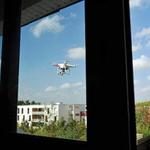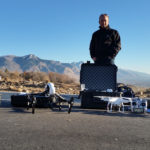Randy Dryer is a lawyer and professor of law at the S.J. Quinney College of Law at the University of Utah. I recently had the opportunity to speak with him about the implications of drones for privacy rights.
Zeke Peterson: How does your work give you a unique perspective on issues involving drones?
Randy Dryer: I teach privacy law at the S.J. Quinney College of Law, in connection with that course I become familiar with the various laws that govern privacy, whether they’re constitutional, statutory, or common law. Drones are not inherently invasive of privacy, but they’re able to deploy various technologies that potentially can be privacy invading. These include high-powered cameras, infrared technology, thermal imaging, facial recognition, and audio recording devices. Most of those technologies have been utilized not in the context of a drone but in the context of a fixed wing aircraft or a police car. There’s some case law, statutory interpretation, and common law that applies to these technologies, albeit not in the context of a drone. Having that basic understanding of privacy laws is helpful in applying that to this new “delivery method” of drones.
Peterson: How do drones most threaten the privacy of individuals?
Dryer: The characteristics that make drones so promising for commercial use or for law enforcement such as maneuverability, video and audio capabilities, and low cost also make drones potentially very invasive of privacy. The privacy concerns really center around the ability of drones to track people’s movements and locations, as well as to engage in surreptitious monitoring or stalking. This can be done because drones fly undetected at high altitudes or because of their small size. The other area of concern is that as drone technology increases, so does the ability to invade people’s private space in which individuals have a reasonable expectation of privacy. Whether it’s government spying on citizens, citizens spying on each other, or businesses using drones to collect data about persons for commercial purposes, all raise concerns about invasive technologies.
Peterson: How can drones be successfully integrated into governmental or commercial uses without threatening privacy rights?
Dryer: The best way would be if the FAA, which has been mandated by congress to integrate drones into national airspace, includes in its regulatory scheme a method to address privacy concerns. There’s a lot of speculation that the FAA will require someone to get a license to operate a drone, which would require an application. One possible route for the FAA is to, during the application process, require the applicant to include a privacy statement that lays out what information the applicant is collecting, and what they intend to use it for. That would address a lot of the privacy concerns. In this way, the FAA or FTC could enforce the privacy statement, as is currently being done to regulate consumer privacy with social networks or websites. These companies can be fined if they promise a level of privacy and don’t deliver, and this same concept could be applied to drone operators. For example, a film company shooting a movie would indicate in their application who they are, why they’ll be flying drones, what information will be collected, and for what purposes they’ll use the information. That would prevent them from taking that data and selling it for commercial purposes. That would be the best way to really address privacy concerns with widespread usage of drones. If that doesn’t happen then every state will pass its own laws trying to regulate the usage of drones and privacy violations will be adjudicated on a case by case basis. This would result in a lot of uncertainty. Many current privacy laws are applicable to drone usage, and many suggest that instead of writing new laws, we simply amend those we currently have to include drones. The problem with this is that it would result in inconsistent results depending on what state you’re in, and it could take many years to develop case law such that operators of drones will be able to understand what they can and cannot do.
Peterson: How do regulations concerning drones and privacy differ between private and public entities?
Dryer: Even though the privacy issues are in many ways similar between public and private persons, there are some significant legal differences between the two entities. The fourth amendment acts as a check against government, protects citizens from being subject to unreasonable search and seizure. If the government has a search warrant, the search or seizure is presumptively reasonable. If the government does not have a search warrant, the search or seizure is presumptively unreasonable. A lot of the concern that’s been expressed in various states is around government use of drones, and of course the primary use of drones in law enforcement is for surveillance and to track and apprehend criminals. One issue that has arisen in this debate is whether drones should be equipped with weapons. Obviously the U.S. military uses weaponized drones for targeted killing, but what if local law enforcement officers wanted to have drones equipped with anti-personnel devices? This could be effective to put fewer people in harms way in a situations such as a when a criminal has taken hostages. It can be very cost effective for law enforcement to use drones. That creates fourth amendment issues that don’t come into play when an individual is using a drone. Many states, including Utah, have passed laws that says law enforcement may not use drones for surveillance without obtaining a warrant. That would only apply to state actors, not to private citizens. That’s the big difference between government use of drones, which implicates the fourth amendment, and private use, which doesn’t implicate the constitution, but is affected by some statutes and common law.



